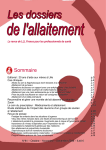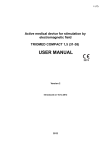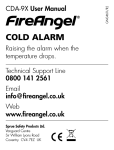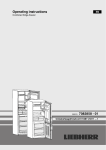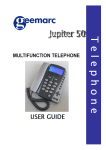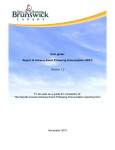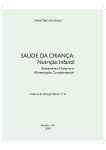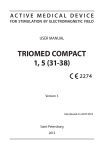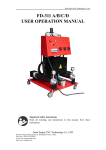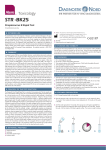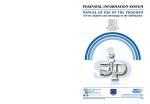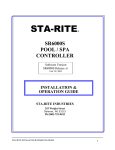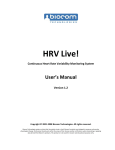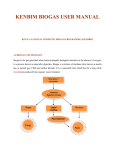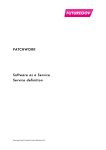Download Supporting Breastfeeding and Lactation
Transcript
8/1/2014 Supporting Breastfeeding and Lactation: The Primary Care Pediatrician’s Guide to Getting Paid Affordable Care Act The Affordable Care Act (ACA) has two major provisions affecting breastfeeding - (1) coverage of comprehensive lactation support and counseling and (2) costs of renting or purchasing breastfeeding equipment for the duration of breastfeeding. These provisions, however, are typically linked to maternal benefits under the insurance plans and therefore coverage may be dependent upon submitting claims under the mother’s name. If pediatric providers plan to provide these services and expect the claims to be adjudicated with benefits covered under ACA provisions, the claim may have to be submitted under the mother’s name and not the baby’s. Check with your payers under the essential health benefits for more details. Remember that services provided out of a payer’s network can be subject to cost sharing. Use modifier 25 appended to a separately reported office or other outpatient service to bill for extended time spent on feeding problems at a well baby visit. Bill for care provided for the mother, often as a new patient, in addition to billing for the baby, if history, exam, diagnosis and treatment are done for her. A new patient is one who has not received any professional face-to-face services rendered by physicians and other qualified health care professionals who may report evaluation and management services reported by a specific CPT code(s) from the physician/ qualified health care professional or another physician/ qualified health care professional of the exact same specialty and subspecialty who belongs to the same group practice, within the past three years. Below is a link to a Section on Breastfeeding resource on ACA provisions and federal support for breastfeeding. Also the section has developed a letter for payers. The practice can also, under specific circumstances, charge for services provided by nurses and such allied health professionals as lactation consultants, health educators, and nutritionists, using a variety of codes. FEDERAL SUPPORT FOR BREASTFEEDING This fact discusses: Breastfeeding support can often be quite time-intensive initially but pays off in a healthier patient population. It is in your insurers’ best interests that you provide these services, and be reimbursed appropriately. 1. 2. 3. 4. 5. 6. 7. This pamphlet is a guide to help pediatric practitioners get paid appropriately for their time as they incorporate more breastfeeding support into their practices. Billing for problems with breastfeeding and lactation is just like billing for any other pediatric problem. Pediatricians and other billable licensed practitioners (nurse practitioners* and physician assistants*) may: Use current Current Procedural Terminology (CPT®) codes. Use current ICD-9-CM codes. Code based on time, if greater than 50% of time is spent in counseling, education, or coordination of care The three- to five-day visit The AAP recommends 1,2,3 this visit to assess jaundice in ALL infants, regardless of feeding method. to address other early feeding issues For breastfeeding infants, the purpose of this visit is to assess weight, hydration and jaundice and to address the ability of the infant to: Options for billing the three-to-five day visit Billing for extra time spent at well baby visits Use of time-based coding Billing for consults Billing for care provided for the mother Billing for allied health professional services Commonly reported ICD-9-CM (for use before Oct 1, 2014) and ICD-10-CM codes (for use on or after Oct 1, 2015) 8. Codes for breast pump *Unless restricted by their state or payers’ scope of practice limitations. This pamphlet does NOT discuss the detailed, important and specific guidelines affecting decisions about billing for nurse practitioners and physician assistants, i.e., whether credentialed and billed under their own names vs. billing for their services “incident to” physician care and thus billed under the physician’s name. That topic is beyond the scope of this pamphlet. However, all physicians employing such allied health care providers need to be aware of, and understand, the applicable billing rules, and apply them carefully—whether billing for feeding problems, or for any other medical services in the pediatric office. 1. Maintain hydration AND 2. Sustain growth and activity AND 3. Increase and maintain maternal production. This assessment usually includes: 1. History: Infant feeding, sleep and activity patterns, urine and stool output; maternal lactogenesis, comfort and confidence 2. Exam: Weight, and exam for dehydration, sleepiness and level of jaundice Current Procedural Terminology® 2013 American Medical Association. All Rights Reserved. 3. If indicated, observation of a feeding, including weights before and after feeding 4. Testing, interventions, and counseling if indicated The visit may be billed as either a first routine well visit OR a follow-up visit, for a problem noted earlier Billing as a well visit If the infant’s previous record does not document a feeding problem, and no other health problem has been identified, then this first office visit should be coded and billed as an established patient well-child visit. CPT code 99391 ICD-9-CM V20.32 (and any other indicated diagnosis codes, eg, for jaundice or feeding problem) In any well visit, the clinician is expected to spend time addressing routine feeding issues. When unusual time beyond the usual is required, there are two ways of billing for this extra time. When extra time is required: If, a feeding problem exists which requires more than an ordinary amount of time to address, the physician may, depending on the circumstances, choose one or both of the following options, as clinically appropriate: Prefer to spend extra time at this visit to address the problem immediately. This may then be billed separately using the 99212-99215 codes appended with the modifier 25, following the guidelines described on the next page Schedule a follow-up visit, for example, within a few days, or at one to two weeks of age. That follow-up visit would then be billable using the office follow-up codes (99211-99215) related to that feeding problem diagnosis. Coding and billing as a follow-up visit For this to be billed as a follow-up visit, the reason for follow-up must be clearly established on the preceding health or hospital record. The earlier chart must document the unresolved problem that requires a follow-up visit. An appropriate diagnosis code, e.g., “newborn feeding problem” (779.31), or “jaundice” (774.6) must be included with the hospital or birth center’s discharge diagnoses, to establish the reason for the follow-up visit. Alternatively, telephone chart notes document that, since discharge, a new problem exists. Examples of early problems requiring follow-up include, but are not limited to: Jaundice Infrequent and/or dark stools Ability to transfer milk not established Infrequent breastfeeding Weight loss exceeds 7% Breastfed infant being fed formula Options for coding and billing as a follow-up visit: 1. Schedule routinely with physician or billable licensed health care provider (e.g., NP or PA): Use office follow-up codes 99212–99215 and appropriate ICD-9-CM codes: If the feeding problem persists, use an ICD-9-CM such as 779.31, 774.6, 783.21, etc. If, however, the feeding problem has resolved, use instead ICD-9-CM code V67.59, just as you would for a follow-up resolved otitis media. 2. Nurse visit with possible triage to physician or other billable licensed health care provider This is a weight check and quick screen for feeding, sleep, and stool patterns. It is only billable to the nurse as a 99211 if it is NOT triaged to the doctor. Triage based on adequacy of feeding: a. If this visit demonstrates that good feeding has been established, the physician does not need to see the patient to bill for a limited nurse’s visit with CPT code 99211 and ICD-9-CM code V67.59. b. If nurse’s weight check visit reveals persistent problems, you do NOT bill for the nurse visit but instead triage back to pediatrician, or other billable health care practitioner (NP or PA) immediately for a problem visit, billable as a follow-up visit (99212–99215) Billing for extra time spent on feeding problems at any well baby visit If, at a well visit, a significant, separately identifiable, diagnosable feeding problem necessitates extra time beyond routine well visit feeding counseling, then the 99212-99215 codes appended with the modifier 25 may be reported in addition to the preventive medicine service code. A separate note is optimally written, on a separate page or on the same page with a line separating the two notes: the well visit note and the problem based note. Furthermore, the problem-based note will require that all required key components of appropriate time-based billing is documented for the code selected. Current Procedural Terminology® 2013 American Medical Association. All Rights Reserved. Both visits are then reported, appending the modifier 25 to the problem-based visit code. For example, using an established patient 8 to 28 days old, you would report: 99391 99212 25 779.31 Note: Some payers do not pay for both E/M services on the same date. V20.32 Billing for any clinician’s visit based on time Because breastfeeding visits are dominated by counseling and education, they can be time-intensive. The CPT guidelines allow for a visit to be billed based on time, rather than by meeting the E/M requirements for elements of history, physical, and decision-making, if: 1. More than 50% of the practitioner’s face-to-face time with the patient has been spent on counseling (patient education) or coordination of care 2. You must document on the chart: a. Your total face-to-face time with the patient and/or the patient’s family. b. Time spent in counseling or coordination of care (and this must be > 50% of total) c. A brief description of what was discussed (should be one or more: diagnosis or impressions; prognosis; risks/benefits of management options; instructions for management and follow-up; compliance issues; risk factor reduction; patient and family education); a checklist on your encounter form will make this easier for all timebased visits, not just those about breastfeeding issues You can bill for time for most routine E/M codes, eg, 99212–99215, when counseling, education, or coordination of care dominate a visit otherwise not meeting customary guidelines for history, physical, and medical decision-making. (It should be noted that time-based billing cannot be used with the preventive medicine service codes, since their CPT code descriptors do not contain “typical times”) Also note that typical times are not threshold times and you do not need to reach the time listed in a specific code in order to report it, but must be closer to that time, then the time listed in the code below. The CPT E/M guidelines for billing based on time: New Patient Time 99202 20 99203 30 99204 45 99205 60 Established Patient Time 99212 10 99213 15 99214 25 99215 40 Outpatient Consult Time 99241 15 99242 30 99243 40 99244 60 99245 80 [For example, if you spent 35 minutes face to face with an established baby and mother, of which greater than18 minutes were spent counseling about feeding issues, you could bill with CPT code 99215, ignoring the usual history, exam, and medical decision-making requirements for a 99215. Since 35 minutes is closer to 40 minutes (99215) rather than 25 minutes (99214), you would report a 99215. Your chart documentation must include the three elements described above: total physician face-to-face time, total time spent counseling, and a description of that counseling.] Consultations The physician or individually credentialed nurse practitioner or physician’s assistant* may also bill the initial feeding evaluation as a requested consultation if the following guidelines are met: even a La Leche League leader) is documented and the original request is to gather your advice or opinion. This cannot be a transfer of care. 2. Render the service requested 3. Report back to requesting source (Note: must be a written report.) Billing for codes 99241-99245 may be based either on key components or time. A requested consultation (99241–99245) requires the “3 Rs,” documentation on chart of: 1. Request (whether verbal or written) from another physician (even within the practice) “or other appropriate source” (can be a lactation consultant or Follow-up visits will be billed as established patients (99212–99215). * An allied health car provider cannot bill a consult under the “incident to” billing options. Only a nurse practitioner or physician’s assistant who has been credentialed individually by an insurance company may bill for either of these types of consults under that provider’s own name. Note: This is subject to individual state and payer limitations. Current Procedural Terminology® 2013 American Medical Association. All Rights Reserved. Billing for the Infant’s Mother If the physician or other billable licensed health care provider is taking the mother’s history, examining her breasts and nipples, observing a feeding, and making a diagnosis and treatment plan for her, the clinician is treating a second patient. This may change the visit with the baby into two separate and identifiable visits with two different patients—two patients, two visits, two records, two bills, and two co-pays. Remember under the ACA provisions, in order to not incur cost sharing, these services may need to be submitted under the mom and not the baby. Depending on the mother’s insurance, you may need to get a request from her primary care health care provider. Can be billed either as a new patient (99201–99205) or, if you have a request and will make a written report back to the requesting source, as a consult (99241–99245) Billing for services by allied health providers who are neither nurse practitioners nor physician’s assistants Services provided by an allied health professional who is not a billable and credentialed nurse practitioner or physician’s assistant, (e.g., a nurse, health educator, or lactation consultant) can be billed two ways. A. The allied health professional’s time can be used to make the physician’s time more productive. B. The Health Behavior Assessment and Intervention codes allow the allied health professional to see the patient alone and bill for the allied health professional’s face-to-face time. A. Joint visit physician and allied health professional: (99212–99215) This is a physician visit which is supported and facilitated by the initial work of the allied health professional. The latter begins the visit, records the chief complaint, documents the history, establishes key physical findings, observes and documents the breastfeeding encounter, and counsels the patient about lactation issues related to the problem. The physician can join the allied health provider, baby, and mother partway through the encounter and then: 1. Review the history 2. Examine the infant to confirm and/or add to the physical 3. Document in the chart the physician’s physical findings, diagnoses and plans 4. Write any necessary prescriptions. With the help of the allied health provider, physician time spent on history taking, counseling, and education will be minimized. History, physical, and medical decision-making guidelines will be used to decide the level of the visit code (99212– 99215). Time based coding cannot be used for this visit because the physician will have spent relatively little time face-to-face with the family. Time based coding is based specifically on the physician’s time, NOT the allied health professional’s time. B. Health and Behavior Assessment and Intervention codes After a breastfeeding (or any other health) problem has been established by the physician, a qualified nonphysician health care professional may see the patient to identify the psychological, behavioral, emotional, cognitive, and social factors important to the prevention, treatment or management of physical health problems. The focus in on the biopsychosocial factors important to physical health problems, and treatments (the AMA’s CPT manual, 2014 page 591). The following conditions apply: 1. These require a medical condition (e.g., feeding problem or low weight gain) previously diagnosed by the physician at an earlier date. 2. These health and behavior visits may not be reported on the same day as any other E/M service. 3. These visits are not for generalized preventive counseling or risk factor reduction. 4. These are billable in 15-minute time increments, based on the allied health professional’s time (they are not for use by physicians or other billable licensed health care provider). If honored by the insurer, these codes are well reimbursed and are a good way to pay for your office lactation consultant who is not otherwise licensed or credentialed for billing. Codes 96150 Initial health and behavior assessment (clinical interview, behavioral observations, health questionnaires, etc.): Each 15 minutes face-to-face time 96151 Reassessment 96152 Health and behavior intervention, individual Each 15 minutes face-to-face time 96153 Health and behavior intervention, group (two or more patients) Note: you will need a group of five or six to be reimbursed for the allied health professional’s time equivalently to the individual or family sessions. Each 15 minutes face-to-face time 96154 Health and behavior intervention, family, with patient present Each 15 minutes face-to-face time 96155 Health and behavior intervention, family, without patient present Each 15 minutes face-to-face time Current Procedural Terminology® 2013 American Medical Association. All Rights Reserved. Billing for phone calls and online communications Certain non-face-to-face services codes have been updated for 2008. The updated E/M codes for telephone and online medical discussions permit billing for both physician services and services provided by “qualified nonphysician health care professional(s)”. Billing for these services is limited to the following circumstances: The telephone or online communication is with an established patient, or an established patient’s parent or guardian. NOT for NEW patients. The online codes (but not the telephone codes) additionally may be used for communications with the patient’s health care provider. The telephone or online service does NOT originate from a related E/M service or procedure for that patient within the previous 7 days The telephone E/M codes may NOT be used if the call leads to a face-to-face E/M service or procedure within the next 24 hours, or the soonest available appointment. (The online E/M codes do not carry this restriction.) Note: Not all insurers reimburse for these codes. Medical Discussion in minutes 5-10 minutes Physician Calls Non-physician Provider Calls 99441 98966 11-20 minutes 99442 98967 21-30 minutes 99443 98968 Online Medical Evaluations E/M services provided to an established patient, or guardian using the internet or similar electronic communications network not originating from a related E/M service in the previous 7 days may be billed, regardless of length, using codes 99444 for services provided by a physician 98969 for services provided by a qualified nonphysician health care professional. Telephone Calls Provided the criteria above are met, telephone calls may be billed using the following codes: Billing for Interdisciplinary Team Conferences The codes for billing for participation in interdisciplinary medical team conferences attended by other health professionals have been updated for 2008. To bill for participation in team meetings when the patient or family is present Physicians continue to use regular E/M codes, e.g. 99214 or 99215, using time as the controlling factor, based on face-to-face time spent on “counseling and coordination of care.” To bill for participation by non-physician qualified health care professionals, use 99366 for meetings of 30 minutes or more To bill for participation in team meetings of 30 minutes or more when the patient or family is NOT present: 99367 participation by physician 99368 participation by non-physician qualified health care professional To bill for codes 99366- 99368 there must be a minimum of 3 qualified health care professionals in attendance 1 American Academy of Pediatrics, Subcommittee on Hyperbilirubinemia. Management of hyperbilirubinemia in the newborn infant 35 or more weeks of gestation. Pediatrics. 2004;114:297-316 2 American Academy of Pediatrics, Committee on Practice and Ambulatory Medicine. Recommendations for Preventive Pediatric Health Care. Pediatrics. 2000;105:645 3 American Academy of Pediatrics, Committee on Fetus and Newborn. Hospital stay for healthy term newborns. Pediatrics. 2010; 125:2 405-409; published ahead of print January 25, 2010, doi:10.1542/peds.2009-3119 Current Procedural Terminology® 2013 American Medical Association. All Rights Reserved. Codes for Breast Pumps HCPCS Codes E0602 - Breast pump, manual, any type E0603 - Breast pump, electric (AC and/or DC), any type E0604 - Breast pump, hospital grade, electric (AC and/or DC) any type Commonly Reported Diagnosis Codes Baby Feeding problems Feeding problems/ slow feeding, newborn Bilious vomiting in newborn Other vomiting in newborn Feeding problem, infant (> 28 days) Vomiting, infant (>28 days) ICD-9-CM 779.31 779.32 779.33 783.3 787.03 Jaundice Breastmilk jaundice Neonatal jaundice, unspecified Preterm jaundice 774.39 774.6 774.2 Weight and hydration Dehydration, neonatal Failure to thrive, newborn Weight loss Underweight Slow weight gain, FTT, infant (>28 days) Abnormal weight gain As well as all the diagnoses associated with size and maturity. 775.5 779.34 783.21 783.22 783.41 783.1 780.91 780.92 789.7 GI issues Abnormal stools Diarrhea Change in bowel habits 787.7 787.91 787.99 Mouth Ankyloglossia High arched palate Breast & Nipple issues Abscess, breast / Mastitis, infective Blocked milk duct / Mastitis, interstitial Breast engorgement, ductal Burning pains, hyperesthesia Ectopic or axillary breast tissue Galactocele Other specified nipple/breast anomaly Other specified nipple/breast infection Nipple infection Nipple, cracks or fissures Nipple, sore Retracted nipple, postpartum Impetigo (staph), nipple Candidiasis, nipple or breast ICD-9-CM 675.14 675.24 676.24 782.0 757.6 676.84 757.6 675.84 675.04 676.14 676.34 676.04 684 112.89 Constitutional Disrupted sleep cycle Fatigue 780.55 780.79 Lactation Infant distress Fussy infant/baby Excessive crying, infant Infantile colic or intestinal distress Mother^ 750.0 750.26 Agalactia, failure to lactate Lactation, delayed Lactation, suppressed Other specified disorders of lactation Supervision of lactation 676.44 676.84 676.54 676.84 V24.1 Other Other specified follow-up exam V67.59 (When the original reason for visit has resolved) ^ICD-9-CM Codes 630 – 679 are only for use on the maternal record Other Other specified follow-up exam V67.59 (When the original reason for visit has resolved) Report ICD-9-CM codes through September 30, 2015 Current Procedural Terminology® 2013 American Medical Association. All Rights Reserved. Feeding problems ICD-10-CM* P92.01 P92.09 P92.1 P92.2 P92.3 P92.5 P92.8 P92.9 Bilious vomiting of newborn Other vomiting of newborn Regurgitation and rumination of newborn Slow feeding of newborn Underfeeding of newborn Neonatal difficulty in feeding at breast Other feeding problems of newborn Feeding problem of newborn, unspecified R11.10 Vomiting, unspecified (>28 days old) R11.12 Projectile vomiting (>28 days old) R11.14 Bilious vomiting (>28 days old) Jaundice P59.0 P59.3 P59.8 P59.9 Neonatal jaundice associated with preterm delivery Neonatal jaundice from breast milk inhibitor Neonatal jaundice from other specified causes Neonatal jaundice, unspecified Weight and hydration P74.1 P74.2 P74.3 P92.6 R62.51 R63.4 R63.5 R63.6 Dehydration of newborn Disturbances of sodium balance of newborn Disturbances of potassium balance of newborn Failure to thrive in newborn Failure to thrive in child over 28 days old Abnormal weight loss Abnormal weight gain Underweight Infant distress R68.11 Excessive crying of infant (baby) R68.12 Fussy infant (baby) R10.83 Colic GI issues R19.4 R19.5 R19.7 R19.8 Change in bowel habit Other fecal abnormalities Diarrhea, unspecified Other specified symptoms and signs involving the digestive system and abdomen Mother^ ICD-10-CM* Breast & Nipple issues B37.89 L01.00 O91.02 O91.03 O91.13 Candidiasis, breast or nipple Impetigo, unspecified Infection of nipple associated with the puerperium Infection of nipple associated with lactation Abscess of breast associated with lactation/Mastitis purulent O91.23 Nonpurulent mastitis associated with lactation O92.03 Retracted nipple associated with lactation O92.13 Cracked nipple associated with lactation Q83.8 Other congenital malformations of breast (ectopic or axillary breast tissue) R20.3 Hyperesthesia (burning) Constitutional G47.23 Circadian rhythm sleep disorder, irregular sleep wake type G47.9 Sleep disorder, unspecified R53.83 Fatigue Lactation O92.3 O92.4 O92.5 O92.6 O92.70 O92.79 Z39.1 Other Z09 Agalactia Hypogalactia Suppressed lactation Galactorrhea Unspecified disorders of lactation Galactocele (Other disorders of lactation) Encounter for care and examination of lactating mother (Excludes encounter for conditions related to O92.-) Encounter for follow-up examination after completed treatment (When the original reason for visit has resolved) ^Do not use any codes listed under the mother for the baby’s medical record Mouth Q38.1 Q38.5 Ankyloglossia Congenital malformations of palate (high arched palate) Other Z09 Encounter for follow-up examination after completed treatment (When the original reason for visit has resolved) *Report ICD-10-CM codes for services on or after October 1, 2015 Current Procedural Terminology® 2013 American Medical Association. All Rights Reserved.







